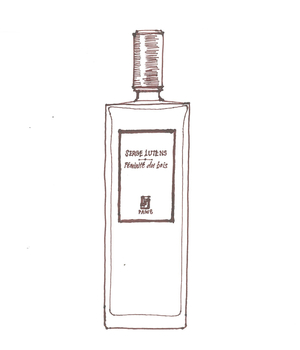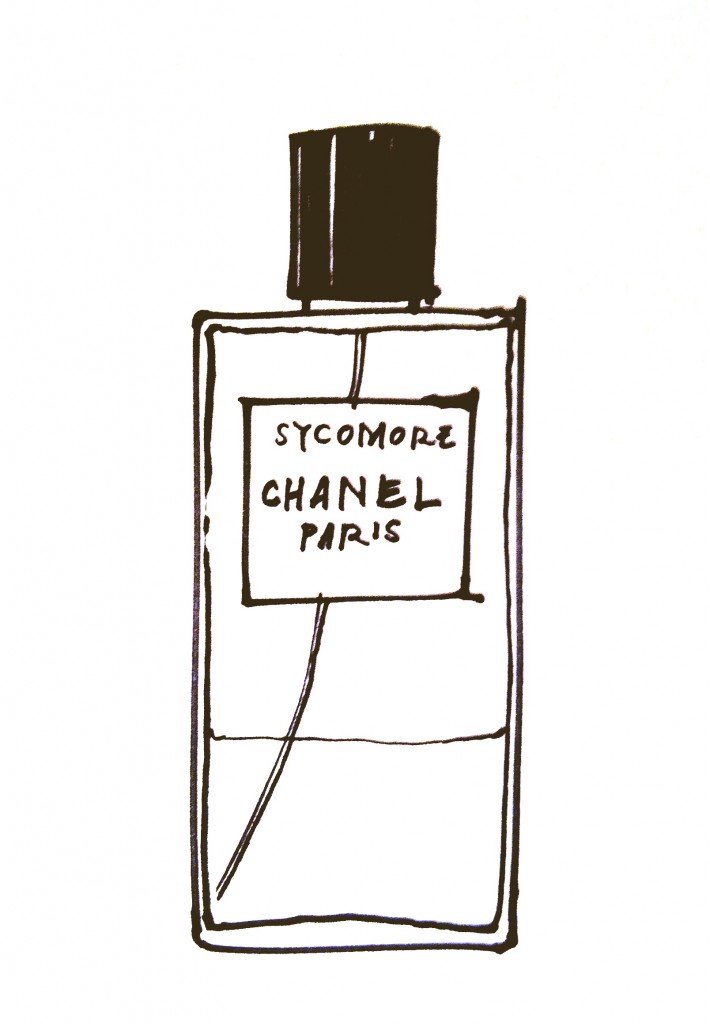Tagged With ‘“Christopher Sheldrake”’
Serge Lutens
Féminité du Bois
20 October, 2014
 Féminité du Bois was launched in 1992 for Shiseido, the Japanese beauty company for which Serge Lutens created many striking ad campaigns, and which backed him in the launch, the same year, of his super-chic Salons du Palais Royal. It was in its original incarnation that I first encountered Féminité du Bois, and what first caught my eye was the design of the bottle – a lovely teardrop-shaped glass container, designed by Lutens himself.
Féminité du Bois was launched in 1992 for Shiseido, the Japanese beauty company for which Serge Lutens created many striking ad campaigns, and which backed him in the launch, the same year, of his super-chic Salons du Palais Royal. It was in its original incarnation that I first encountered Féminité du Bois, and what first caught my eye was the design of the bottle – a lovely teardrop-shaped glass container, designed by Lutens himself.
Sadly that style of bottle disappeared in 2009, when Lutens left Shiseido and set up in his own name; the perfume went with him, repackaged in his signature bottles – a tall, slim, rather flat rectangular design, stylish in its own right but not as poetic as Shiseido’s original.
Recommending a perfume called Féminité du Bois to men might sound like a rather capricious (not to say perverse) enterprise, but many great fragrances transcend the gender associations that their names, and their marketing, impose on them, and this is one of the most beautiful fragrances I know.
Floral scents may be thought of as quintessentially feminine, and it would take a very confident man to wear something that smelled predominantly, say, of jasmine or of rose. Yet some of the most popular men’s perfumes have flowers in them – violets in Grey Flannel, for example, or jasmine in Eau Sauvage.
Féminité du Bois is, if you like, a mirror image of these kinds of men’s fragrance: a nominally female fragrance made more, rather than less alluring by the addition of elements that are generally associated with the opposite sex. The master stroke, in this case, is the combination of sweet, rather girly smells – violets and plum (the fruit rather than the flower) – with the masculine, pencil-shaving smell of cedar wood.
It’s one of those combinations that works so well that you wonder why nobody had thought of it before, but I guess that’s the mark of genius – in this case the genius of British perfumer Christopher Sheldrake (who worked on many of the Serge Lutens fragrances before getting snapped up by Chanel) and the legendary Pierre Bourdon (Cool Water, Kouros and many others).
The first time I tried out Féminité du Bois my reaction was ‘This smells exactly like Bel Ami’. Which is to say, like pencil shavings, which is the main – and very appealing – impression you get from the classic Hermès scent. But moments later you realise that there’s more going on inside the woodiness, and the warmth and slight sweetness of plum, violets and spices blend with the cedar to make an effortlessly satisfying whole.
Luxury can mean different things to different people: for some, bling is the thing, but for others luxury means high quality and discretion – and that’s the kind of luxury Féminité du Bois suggests to me. It’s neither brash nor overpowering, which makes it eminently wearable, but nor is it faint or feeble. Try it for yourself and I hope you’ll see what I mean.
Chanel
Sycomore
28 May, 2014
 Until recently, Sycomore was one of the most extraordinary perfumes that I know (see note, below). OK, its name looks like a misspelling of sycamore, a tree that – in Britain at least – no right-minded person would name a fragrance after. Sycamores, after all, are as common as muck, breed like rabbits and are often looked down on by ecologists as they’re not even native trees.
Until recently, Sycomore was one of the most extraordinary perfumes that I know (see note, below). OK, its name looks like a misspelling of sycamore, a tree that – in Britain at least – no right-minded person would name a fragrance after. Sycamores, after all, are as common as muck, breed like rabbits and are often looked down on by ecologists as they’re not even native trees.
Acer pseudoplatanus, to give the tree its proper botanical name, is also responsible for many of those deeply irritating ‘leaves on the line’ excuses that railway companies give out each autumn to explain why their trains are running late. Worst of all, from a perfume perspective, they don’t even really smell of much, though their leaves do have the faintest leathery scent and their wood, once dried enough, burns with a pretty generic woodsmoke smell.
So is Sycomore just an example of misguided marketing, like Ralph Lauren’s dreadfully named Glamourous? Actually, no. Coming from arguably the world’s most tightly policed brand, its name will have been very carefully considered – and actually it almost certainly refers not, as I’d initially thought, to Acer pseudoplatanus at all but to a rather more exotic tree, the so-called Sycomore fig.
Ficus sycomorus (to use its Latin name) is a large, spreading tree that grows across central Africa and the Middle East, where its heavy shade is much appreciated; it was known to the Egyptians as the Tree of Life. It’s a tree I haven’t sniffed, but my guess is that it shares at least some of the dry, green, slightly fruity scent that we know from other varieties of fig – though ironically there’s only the faintest hint of figginess in Sycomore.
Anyhow, enough about the name. What makes Sycomore extraordinary, for me, is a trick it seems to be able to do that no other perfume I’ve come across seems to be able to do. This is to smell like two completely different scents, depending on whether you smell it close up or at a distance. Up close it has the strong, earthy, pleasantly bitter scent of vetiver, the root of an Indian grass that’s related to lemongrass and citronella. It’s also grown commercially in the Caribbean, and apparently Chanel’s super-high-quality vetiver originated in Haiti.
Vetiver is usually classed as one of the great masculine fragrances, presumably because of its bracing bitterness and lack of cloying sweetness; it’s certainly not a flowery smell. But it also has a warmth and – get this – a touch of smokiness that gives it extra depth and complexity, especially when it’s surrounded by such a delicious cushion of other scents, which mix smokiness with a slightly sweeter touch of fruit. Vetiver is also famous for its staying power, and a spritz of Sycomore can last you all day.
It’s the added fruitiness that, on occasion, one gets a whiff of when someone wearing Sycomore strolls by, and then it’s like a different, warmer, sweeter fragrance altogether, with hardly a hint of the vetiver that dominates the perfume on the skin. If it’s an intentional trick I’m in awe, though it seems perfectly possible, given that Sycomore was created by Chanel’s chief nose Jacques Polge in collaboration with Christopher Sheldrake, the legendary British perfumer who has been Chanel’s director of research and development since 2005.
Like the other fragrances that belong to Les Exclusifs de Chanel, Sycomore costs about twice as much as your average perfume, but it does come in a typically (for Chanel) handsome bottle, beautifully presented in a chunky white-and-black box. The hidden magnet in the heavy black cap, ensuring that the iconic twin Cs of the Chanel logo always end up perfectly aligned, is a particularly nice touch, even if it has since been adopted by one or two other brands.
Though it’s a classically masculine scent Sycomore is (quite rightly) marketed as a unisex fragrance, and like most men’s perfumes it can smell wonderful on a woman. Yet what I love most is that, from the very first sniff, it has a wonderful feeling of luxury, quality and depth, which are things that are all too often lacking in other perfumes. And who could resist its baffling cleverness, like a cryptic crossword in scent?
Autumn 2016 update. Oh dear: evidently Sycomore hasn’t been a commercial success, as Chanel have recently ‘updated’ it, and now – minus the fruitiness that made it so unusual – it’s a perfectly pleasant, fairly straight-up vetiver. From being unique it’s become one of many. Such a shame – another great perfume gone.